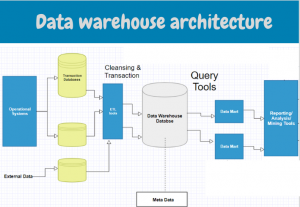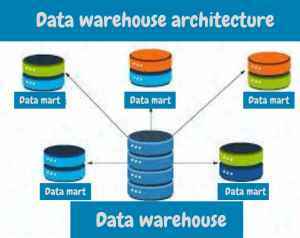Data warehouse
What is a data warehouse?
Data Warehousing (DW) is indeed a procedure for storing and analyzing data from diverse sources that provide significant information into the business. A Data Warehouse is commonly used to connect and evaluate homogenous sources of business information. The data warehouse seems to be the centerpiece of the BI platform designed for collecting and reporting. It is a mixture of technologies in the industry that helps to use data strategically. Rather than transaction processing, it is mechanical or electronic conversion of the quantity of knowledge by a business that is administered to the respondents. It’s a transformation of data into knowledge and providing access for subscribers to make a significant difference in a reasonable manner. The database of decision support (Data Warehouse) is considered separate from the operating database of the organization. The data warehouse, therefore, is not a commodity but rather an atmosphere. This is an architectural framework of a knowledge system that provides consumers with knowledge about current and historical predictive analytics that is hard to acquire or view in the typical organization ’s data.
Architecture.
Data warehouses are designed in several various ways, seeking to accommodate and organize the complexities of the companies using them. The actual data is processed first, also called cleaning and standardizing. You may think about this as a system that transfers raw data from different sources into the warehouse, which means that data is correctly labeled and organized and in specific relationships with the majority of data that is processed. This is sometimes referred to as the information system, which is not actually a part of the information warehouses itself. The configured information is stored back in the data warehouse. An accessibility layer enables the tools and applications to collect data in a format suitable to their needs. There is also another dimension to architectures of the relational database which regulates the entire structure named metadata. Metadata is data with respect to data. The computer scientists and software engineers who manage a data warehouse gather information on data sources, communication protocols, update schedules, etc., using this knowledge to preserve system performance and to ensure that the data warehouse serves its legitimate goals.

Figure 1. Data warehouse architecture
Extract transform load in the data warehouse architecture.
The ETL method plays an important role in approaches for data inclusion. ETL enables organizations to collect and integrate data from different sources into a single, single place. ETL therefore allows for the coordination of data from different sources. The method of extracting data from various data sources, converting it to fit business objectives, and uploading it to a database of destinations is generally called ETL, that accounts for extraction, transformation, then upload. Although ETL is generally defined as three distinct phases, thus this reality streamlines it too much anyway, truly a complex process requiring a multitude of acts.
OLTP and OLAP in the data warehouse architecture.
OLTP (On-line Transaction Processing) has several fast electronic transactions (INSERT, Fix, DELETE). OLTP systems’ key focus is very much on faster data processing, preserving data confidentiality in multiple – access settings, and calculating performance by the number of accounts per cycle. There is detailed and existing information in the OLTP database, as well as the entity model (generally 3NF) is the model used to store modernized.
OLAP (Online Analytical Processing) is commonly attributed to databases that contain and maintain data related to data interpretation and decisions. OLAP is closely related to Business Intelligence ( BI), a software engineering specialty aimed at providing business analytics applications. In many other words, BI ‘s mission is to enable top-level management to access and analyze data by engaging IT workers. It is an electronic framework for data recovery and data analysis. Collect data for the analysis which helps in managing. Specific repositories of OLTPs are the data center for OLAP. In OLAP, a total transaction waiting period is considerably low.
Data Marts in warehouse architecture.
The data mart is really a basic description of a data warehouse based on a specific subject (or organizational unit), like purchases or accounting and finance. Inside a company, data marts are sometimes built up and owned by a single dept. Data marts tend to draw information just from a few other references, due to their single-subject focus. The references might be internal operating systems, a main data warehouse, or critical events.

Figure 2. Data marts in data warehouse architecture
Warehouse vs. Database.
Technically accurate, a database would be any data set that is organized. The Excel spreadsheet, Rolodex, or account book will all be basic database instances. Software including Excel, Oracle, or MongoDB is a DBMS that enables users to freedom and manipulate the database. It is popular to call a database a DBMS. A data warehouse is a storage sort, then. It specializes in the data it collects-and the function it serves-analytics, statistical data from several channels.
Different types of the data warehouse.
There are three main types of Data Warehouse which are below:
- Enterprise Warehouse:
An enterprise data center is a consolidated storage facility. It offers an enterprise-wide policy support center. This allows for a cohesive approach to information management and representation. This also offers the opportunity to identify data by topic as well as provide accessibility according to certain sections.
- Data Mart:
Datamart is just such a storage function associated with an organization’s particular department. This is a type of data that is contained inside the data center. Datamart focuses solely on an organization’s specific purpose and is managed solely by a single authority, e.g. finance, advertising. Data Marts are tiny and versatile.
- Operational Data Store:
An operational data store (ODS) is one approach to fix the drawback of data warehouses that do not provide up-to-date data. An ODS may be regarded as a staging area providing facilities for querying. Just for the purpose of converting the data or loading that into the data warehouse is a standard processing area intended to collect the operational data through transactional outlets. An ODS also provides this feature but it can also be explicitly queried. Through this manner, analytical tools requiring data that is relevant to actual time may query the ODS information as it is obtained from the corresponding source systems until processing and loading procedures take time. The ODS only then offers access to existing, fine-grained, and – anti-aggregated data, that can be questioned in an automated way without saddling the relational systems. Even so, on the specific data warehouse, further complicated analyzes which require high-volume historical and/or data gathered are still performed.